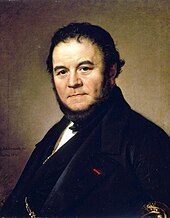Stendhal syndrome, Stendhal's syndrome, hyperkulturemia, or Florence syndrome is a psychosomatic disorder that causes rapid heartbeat, dizziness, fainting, confusion and even hallucinations when an individual is exposed to an experience of great personal significance, particularly viewing art.[1] It is not listed as a recognised condition in the Diagnostic and Statistical Manual of Mental Disorders.
Contents
History[edit]
The illness is named after the 19th-century French author Stendhal (pseudonym of Marie-Henri Beyle), who described his experience with the phenomenon during his 1817 visit to Florence in his book Naples and Florence: A Journey from Milan to Reggio.
When he visited the Basilica of Santa Croce, where Niccolò Machiavelli, Michelangelo and Galileo Galileiare buried, he was overcome with emotion. He wrote:
He had been shown the frescoes in the church including those by Giotto, and modern writers frequently attribute his emotions mistakenly to the latter rather than powerful historical associations of the tombs.[citation needed]
Although psychiatrists have long debated whether it really exists, its effects on some sufferers are serious enough for them to require treatment in hospital.[3] The staff at Florence's Santa Maria Nuova hospital are accustomed to dealing with tourists suffering from dizzy spells and disorientation after admiring the statue of David, the masterpieces of the Uffizi Gallery and other treasures of the Tuscan city.[4]
Even though there are many descriptions of people becoming dizzy and fainting while taking in Florentine art, especially at the aforementioned Uffizi in Florence, dating from the early 19th century on, the syndrome was only named in 1979, when it was described by Italian psychiatrist Graziella Magherini, who observed and described more than 100 similar cases among tourists and visitors in Florence. There is no scientific evidence to define the Stendhal syndrome as a specific psychiatric disorder; on the other hand there is evidence that the same cerebral areas involved in emotional reactions are activated during the exposure to artworks.[5]
See also[edit]
References[edit]
- ^ Nicholson, T. R. J.; Pariante, C.; McLoughlin, D. (2009). "Stendhal syndrome: A case of cultural overload". Case Reports. 2009: bcr0620080317. doi:10.1136/bcr.06.2008.0317. PMC 3027955. PMID 21686859.
- ^ Chatzichristodoulou, Maria; Jefferies, Janis; Zerihan, Rachel, eds. (2009). Interfaces of Performance. Ashgate Publishing, Ltd. p. 196. ISBN 9781409486145.
- ^ "Florence's Art Makes Some Go to Pieces". The New York Times. Italy; Florence (Italy). 15 May 1989. Retrieved 24 April 2015.
- ^ "Scientists investigate Stendhal Syndrome – fainting caused by great art". The Daily Telegraph. London. 28 July 2010. Retrieved 24 April2015.
- ^ Innocenti, Claudia; Fioravanti, Giulia; Spiti, Raffaello; Faravelli, Carlo (1 March 2014). "La sindrome di Stendhal fra psicoanalisi e neuroscienze" [[The Stendhal syndrome between psychoanalysis and neuroscience].]. Rivista di Psichiatria (in Italian). 49 (2): 61–66. doi:10.1708/1461.16139. ISSN 2038-2502. PMID 24770571.


沒有留言:
張貼留言